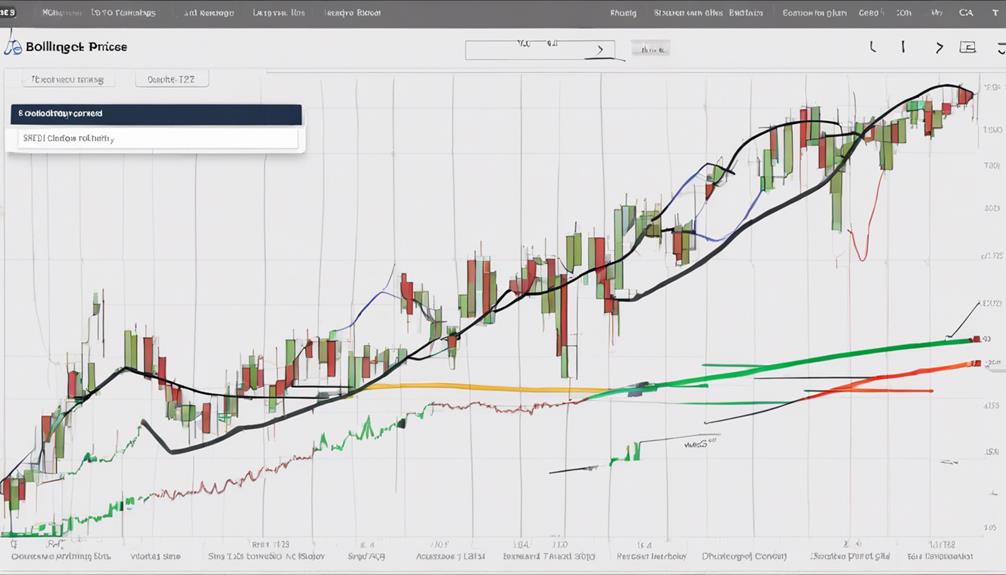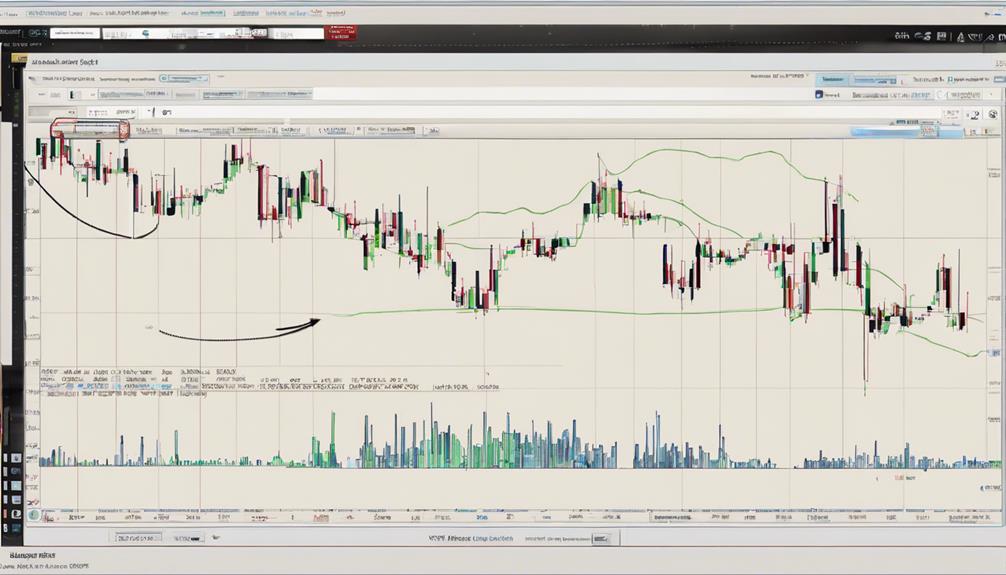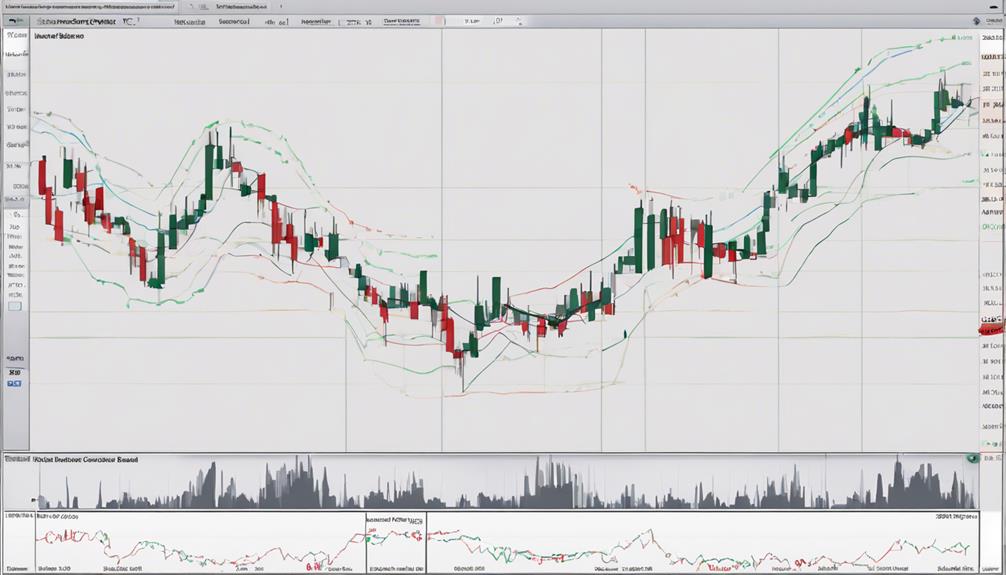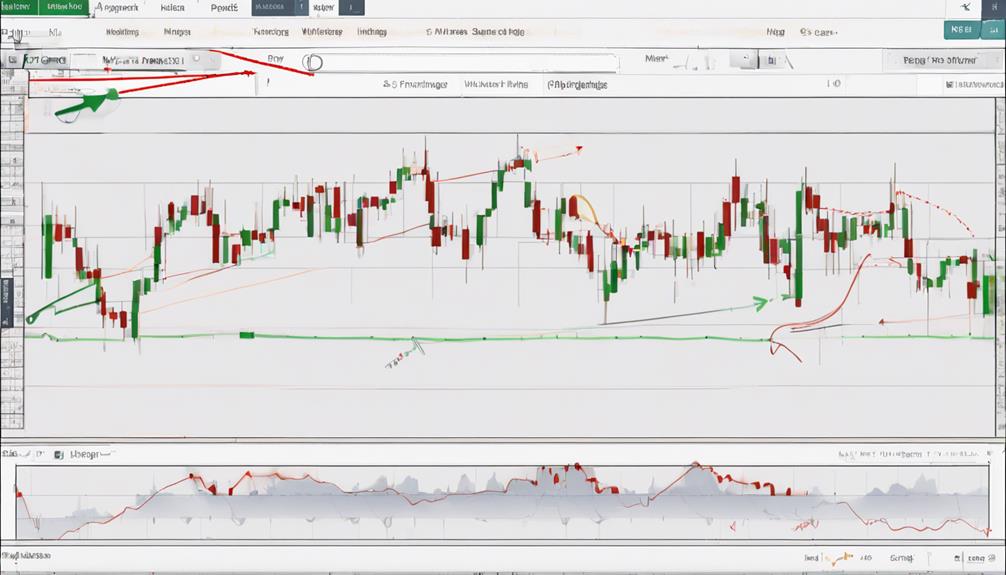You may be surprised to learn that Bollinger Bands have been used by traders for nearly four decades to predict price movements effectively.
With their unique ability to adapt to market conditions, these bands offer a valuable tool for anticipating potential price shifts.
By exploring the five key strategies for utilizing Bollinger Bands, you can gain insights into enhancing your trading decisions and maximizing your profit potential in the dynamic world of financial markets.
Identifying Price Reversals
To effectively identify price reversals using Bollinger Bands, you must observe how the price interacts with the upper or lower bands to anticipate potential shifts in market direction. When the price touches the upper band, it may signal overbought conditions, hinting at a potential downward reversal.
Conversely, touching the lower band might suggest oversold conditions, indicating a possible upward reversal. Traders often seek confirmation signals such as candlestick patterns or divergence to validate these signals from Bollinger Bands.
The combination of Bollinger Bands with other technical indicators can significantly improve the accuracy of predicting price reversals, offering insights into market volatility and aiding in making informed trading decisions.
Measuring Volatility Changes

Expanding or contracting based on price movement, Bollinger Bands serve as a dynamic tool for measuring volatility changes in the market. When the bands widen, it indicates increasing volatility, while narrowing bands suggest decreasing volatility.
The distance between the upper and lower bands reflects the intensity of price fluctuations and helps traders identify potential trend shifts. By monitoring Bollinger Bands, investors can predict price movements and seize opportunities presented by changing volatility levels.
Understanding the gauge of volatility provided by Bollinger Bands is crucial for making informed trading decisions. By analyzing the bands' movements, traders can assess the current market environment and adapt their strategies accordingly to stay ahead of potential trend changes.
Spotting Trend Continuations

How can traders effectively identify trend continuations using Bollinger Bands?
When the price consistently touches or breaches the upper band, it often signifies a robust uptrend continuation. A sustained movement above the upper band indicates bullish momentum and the potential for further price appreciation. To confirm a trend continuation, traders should observe the price staying above the middle band.
Trend continuation signals are stronger when the upper band slopes upward and the price remains above it. By combining signals from Bollinger Bands with other technical indicators, traders can improve the accuracy of price predictions. This integration of trend analysis and technical indicators is crucial for traders looking to capitalize on ongoing bullish momentum in the market.
Determining Overbought and Oversold Conditions

Bollinger Bands serve as valuable indicators for traders to determine overbought and oversold conditions in the market, helping anticipate potential price corrections or trend shifts.
When using Bollinger Bands, keep in mind the following:
- Overbought conditions occur when prices touch or exceed the upper band.
- Oversold conditions are signaled when prices touch or fall below the lower band.
- Traders look for price levels near the bands to determine potential reversals.
These indicators help identify extreme price levels that may lead to a reversal in trend, providing insights into possible price corrections or trend changes. By understanding these signals, traders can better predict market movements and make informed decisions.
How Can Bollinger Bands Help Predict Price Movements?
Bollinger bands and volatility indicators are useful tools for predicting price movements. By measuring volatility and identifying overbought or oversold conditions, these indicators can help traders anticipate potential market shifts. Whether in a trending or ranging market, bollinger bands can provide valuable insights for making informed trading decisions.
Can the Predictive Methods of Bollinger Bands also Lead to Profitable Trading?
Yes, profitable trading with Bollinger bands is possible through predictive methods. By analyzing the upper and lower bands and adjusting to market volatility, traders can anticipate potential price movements. Utilizing additional indicators and risk management can enhance the effectiveness of this strategy, leading to successful trades.
Anticipating Breakouts

To anticipate breakouts effectively in the market, traders can utilize Bollinger Bands to identify periods of low volatility, signaling potential price movements.
The 'Bollinger Squeeze' is a key phenomenon where the bands contract, indicating an impending price breakout or significant move.
When the bands narrow, traders often watch for a bullish breakout above the upper band or a bearish breakout below the lower band.
Breakouts following a Bollinger Squeeze typically suggest strong momentum and potential trend continuation, offering valuable trading opportunities.
It's essential to exercise patience and confirm signals from other technical indicators to validate potential price movements accurately.
Frequently Asked Questions
How Do You Predict With Bollinger Bands?
To predict with Bollinger Bands, analyze price movements relative to the bands. Identify overbought/oversold conditions for potential reversals. Utilize Bollinger Band Squeeze strategy during low volatility. Enhance predictions by combining with indicators like Bollinger %B and Bandwidth for accuracy.
How Do You Use Bollinger Bands Effectively?
To use Bollinger Bands effectively, analyze price volatility for overbought or oversold conditions. Combine with other indicators for accurate signals. Gauge market volatility by band width. Confirm trend reversals with chart patterns. Apply on various timeframes for insightful price predictions.
What Indicator Works Best With Bollinger Bands?
When combining Bollinger Bands with indicators, the Relative Strength Index (RSI) stands out as a top choice for confirming overbought or oversold conditions. Its synergy with Bollinger Bands enhances your analysis and decision-making process effectively.
How Accurate Is the Bollinger Bands Indicator?
Bollinger Bands' accuracy varies; they're reliable in sideways markets but less so in trends. False signals occur during low volatility. To enhance precision, combine with other indicators. Remember, their effectiveness hinges on market conditions and asset type.
Conclusion
In conclusion, mastering the art of predicting prices with Bollinger Bands requires a keen eye for detail and a deep understanding of market dynamics.
By effectively utilizing these technical analysis tools, traders can navigate the complex world of price movements with confidence and precision.
Whether identifying price reversals, measuring volatility changes, or anticipating breakouts, the strategic use of Bollinger Bands can provide invaluable insights that enhance trading strategies and maximize profitability.


